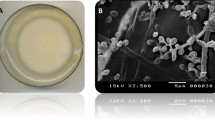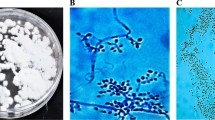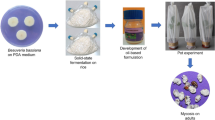Abstract
The entomopathogenic Beauveria spp. were acquired from insect cadavers and soil rhizosphere of cotton, groundnut, and castor. Among Beauveria, five spp. derived from infected insects, eight Beauveria found from soil, and one strain of Beauveria bassiana collected from MTCC 9544. Beauveria were characterized for morphology and cuticle-degrading enzyme activity associated with virulence against Bemisia tabaci. The colony morphology, conidial arrangement, size, and shape confirmed all isolates as Beauveria. The chitinase (EC 3.2.1.14) and lipase (EC 3.1.1.3) activities were observed the highest in Beauveria JAU2, while higher protease (EC 3.4.21.4) activity found in JAU4 followed by JAU2 at 240 h. The bio-efficacy of Beauveria (1 × 107 conidia.ml−1) illustrated that potent JAU2 was examined with the highest % mortality and corrected mortality of B. tabaci at 144 h followed by JAU1. The LC90 and LC50were determined from potent (JAU1 and JAU2) and weak (JAU6), and it was found the lowest in JAU2. The most potent Beauveria JAU2, isolated from insect cadaver (Harmivora armigera), was illustrated higher virulence than other isolates. The Beauveria JAU2 were recognized as Beauveria bassiana based on the shape of conidia and size (2.00 to 2.09 µm dia) as examined in SEM. Study insight into recognition of potent Beauveria bassiana JAU2 was linked with cuticle-degrading enzyme activity for insecticidal action. The JAU2 isolate established the most positive correlation (P0.01: 0.864) between chitinase activity and corrected mortality of insect.





Similar content being viewed by others
References
Abbott WS (1925) A method of computing the effectiveness of an insecticide. J Econ Entomol 18:256–267
Afandhi A, Syamsidi SRC, Mimbar SM, Wiroatmodjo B (2012) Isolation and phenotypic characterization of morphology in fungus Beauveria bassiana (Balsamo) Vuillemin colony naturally from leaf surface soil and insect as host in tomato plantation. Agrivita 34(3):303–309
Akmal M, Freed SH, Malik MN, Gul HT (2013) Efficacy of Beauveria bassiana (Deuteromycotina: Hypomycetes) against different aphid species under laboratory conditions. J Zool 45(1):71–78
Ansari MA, Pope EC, Carpenter S, Scholte EJ, Butt TM (2011) Entomopathogenic fungus as a biological control for an important vector of livestock disease: the Culicoides biting midge. PLoS ONE 6:e16108
Asi MR, Bashir MH, Afzal M, Ashfaq M, Talib-Sahi S (2010) Compatibility of entomopathogenic fungi Metarhizium anisopliae and Paecilomyces fumosoroseus with selective insecticides. Pak J Bot 42:4207–4214
Blanford S, Chan BH, Jenkins N, Sim D, Turner RJ, Read AF, Thomas MB (2005) Fungal pathogen reduces potential for malaria transmission. Science 308:1638–1641
Boller T, Mauch F (1988) Colorimetric Assay for Chitinase. Method Enzymol 161:430–435
Boopathi T, Karuppuchamy P, Kalyanasundaram M (2015) Microbial control of the exotic spiralling whitefly Aleurodicus disperses (Hemiptera:Aleyrodidae) on eggplant using entomopathogenic fungi. Afr J Microbiol Res 9:39–46
Bugti GA, Bin W, Na C, Feng LH (2018) Pathogenicity of Beauveria bassiana strain 202 against sap-sucking insect pests. Plant Protect Sci 54:111–117
Campbell RK, Barnes GL, Cartwright BA, Eikenbary RD (1983) Growth and sporulation of Beauveria bassiana and Metarhizium anisopliae in a basal medium containing various carbohydrates sources. J Invertebr Pathol 41:117–121
Castillo MG, Rivera IA, Padilla AB, Victoriano FL, Aguilar CN, Herrera RR (2012) Isolation and identification of entomopathogenic fungal strains of the Beauveria and Metarhizium generous. Indian J Biotechnol 6(12):386–395
Charney MS, Tomarelli RM (1947) A colorimetric method for the determination of the proteolytic activity of duodenal juice. J Biol Chem 171:501–505
Dhar P, Kaur G (2010) Production of cuticle-degrading proteases by B. bassiana and their induction in different media. Afr J Biochem Res 4(3):65–72
Dhar S, Jindal V, Jariyal M et al (2019) Molecular characterization of new isolates of the entomopathogenic fungus Beauveria bassiana and their efficacy against the tobacco caterpillar, Spodoptera litura (Fabricius) (Lepidoptera: Noctuidae). Egypt J Biol Pest Control 29(1):1–9
Dhawan M, Joshi N (2017) Enzymatic comparison and mortality of Beauveria bassiana against cabbage caterpillar Pieris brassicae LINN. Vet Microbiol 48:522–529
Domsch KH, Gams W, Anderson TH (2007) Compendium of Soil Fungi, 2nd edn, taxonomically revised by W. Gams. IHW-Verlag, Eching, p.672
Ebani VV, Mancianti F (2021) Entomopathogenic fungi and bacteria in a veterinary perspective. Biology 10(6):479
El Kichaoui AY, Asaker BA, El Hindi MW (2017) Isolation molecular identification and under lab evaluation of the entomopathogenic fungi M anisopliae and B bassianaagainst the red palm weevil R ferrugineusin Gaza Strip. Adv Microbiol 7:109–124
Ellsworth PC, Martinez-carillo JL (2001) IPM for Bemisia tabaci a case study from North America. Crop Protec 20:853–869
Faria MR, Wraight SP (2007) Mycoinsecticides and mycoacaricides: a comprehensive list with worldwide coverage and international classification of formulation types. Biol Control 43:237–256
Feng MG, Pu XY, Ying SH, Wang YG (2004) Field trials of an oil based emulsifiable formulation of Beauveria bassiana conidia and low application rates of imidacloprid for control of false-eye leafhopper Empoasca vitisin Southern China. J Crop Prot 23(6):489–496
Finney DJ, Stevens WL (1948) A table for the calculation of working probits and weights in probit analysis. Biometrika 35(1–2):191–201
Fisher RA, Yates ND (1948) “Statistical methods for research workers”. Oliver and Boyd, Edinburgh, London. 12th edition-Biological Monographs and Manuals, 5:130–131
Gurlek S, Sevim A, Sezgin FM, Sevim E (2018) Isolation and characterization of Beauveria and Metarhizium spp from walnut fields and their pathogenicity against the codling moth Cydiapomonella (L) (Lepidoptera: Tortricidae). Egypt J Biol Pest Co 28:50–56
Hegedus DD, Khachatourians GG (1996) Identification and differentiation of the entomopathogenic fungus Beauveria bassiana using polymerase chain reaction and single-strand conformation polymorphism analysis. J Invertebr Pathol 67(3):289–299
Humber RA (2005) Entomopathogenic fungal identification, key to major genera. Available on: https://www. ars. usda. gov/SP2UserFiles/Place/1907051 0. APSwkshoprev. pdf
Hunsley D, Burnett JH (1970) The ultrastructural architecture of the walls of some hyphal fungi. J Gen Microbiol 62:203–218
Imoulan A, Hussain M, Kirk PM, Meziane YY (2017) Entomopathogenic fungus Beauveria: Host specificity ecology and significance of morpho-molecular characterization in accurate taxonomic classification. J Asia Pac Entomol 20:1204–1212
Javed K, Javed H, Mukhtar T, Qiu D (2019) Efficacy of Beauveria bassiana and Verticillium lecanii for the management of whitefly and aphid. Pak J Agri Sci 56(3):669–674
Koo YD, Ahn JE, Salzman RA, Moon J, Chi YH, Yun DJ, Yun SY, Koiwa LH, Zhu-Salzman K (2008) Functional expression of an insect cathepsin B-like counter-defence protein. Insect Mol Biol 17(3):235–245
Kulu IP, Abadi AL, Afandhi A, Nooraidawati S (2015) Morphological and molecular identification of Beauveria bassiana as entomopathogen agent from Central Kalimantan Peatland Indonesia. Int J Chem Tech Res 8(4):2079–2084
Lacey LA, Grzywacz D, Shapiro-Ilan DI, Frutos R, Brownbridge M, Goettel MS (2015) Insect pathogens as biological control agents: back to the future. J Invertebr Pathol 132:1–41
Lee YP, Takahashi T (1966) An improved colorimetric determination of amino acids with the use of ninhydrin. Analytical Biochem 14:71–73
Luangsa-Ard J, Houbraken J, van Doorn T, Hong S, Borman AM, Hywel-Jones NL, Samson RA (2011) Purpureocillium, a new genus for the medically important Paecilomyces lilacinus. FEMS Microbiol Lett 321(2):141–149
Malik CP, Singh MB (1980) Plant Enzymology and Histo Enzymology. Kalyani Publishers, New Delhi, p 286
Mascarin GM (2013) The virulence of entomopathogenic fungi against Bemisia tabaci biotype B (Hemiptera:Aleyrodidae) and their conidial production using solid substrate fermentation. Biol Control 66:209–218
Nahar P, Ghormade V, Deshpande MV (2004) The extracellular constitutive production of chitin deacetylase in Metarhizium anisopliae: possible edge to entomopathogenic fungi in the biological control of insect pests. J Invertebr Pathol 85:80–88
Pedrini N, Crespo R, Juarez MP (2007) Biochemistry of insect epicuticle degradation by entomopathogenic fungi. Com Biochem Physiol 146:124–137
Pelizza SA, Eliades LA, Scorsetti AC, Cabello MN, Lange CE (2012) Entomopathogenic fungi from Argentina for the control of Schistocerca cancellarta (Orthoptera:Acrididae) nymphs: fungal pathogenicity and enzyme activity. Biocontrol Sci Technol 22(10):1119–1129
Pelizza SA, Medina H, Ferreri NA, Elíades LA, Pocco ME, Stenglein SA, Lange CE (2020) Virulence and enzymatic activity of three new isolates of Beauveria bassiana (Ascomycota: Hypocreales) from the South American locust Schistocerca cancellata (Orthoptera: Acrididae). J King Saud Uni Sci 32(1):44–47
Petrisor C, Stoian G (2017) The role of hydrolytic enzymes produced by entomopathogenic fungi in pathogenesis of insects mini review. Rom J Plant Prot 10:66–72
Rakh RR, Raut LS, Dalvi SM, Manwar AV (2011) Biological control of Sclerotiumrolfsii causing stem rot of groundnut by Pseudomonas Cf Monteilii. Recent Res Sci Technol 3(3):26–34
Reissig J, Strominger J, Leloir L (1955) A modified colorimetric method for the estimation of N-acetylamino sugars. J Biol Chem 4:959–966
Sadeh D, Nitzan N, Shachter A, Chaimovitsh D, Dudai N, Ghanim M (2017) Whitefly attraction to rosemary (Rosmarinu sofficinialis L) is associated with volatile composition and quantity. PLoS ONE 12(5):e0177483
Sain SK, Monga D, Kumar R, Nagrale DT, Kranthi S, Kranthi KR (2019) Comparative effectiveness of bioassay methods in identifying the most virulent entomopathogenic fungal strains to control Bemisia tabaci (Gennadius) (Hemiptera: Aleyrodidae). Egypt J Biol Pest Co 29:31–41
Samuels RI, Santos AV, Silva CP (2011) Enzymology of enthomopathogenic fungi. Microbial Insecticides -Principles and Applications, Nova Science Publishers, Inc, pp.71–92
Sevim A, Donzelli BG, Wu D, Demirbag Z, Gibson DM, Turgeon BG (2012) Hydrophobin genes of the entomopathogenic fungus Metarhizium brunneum are differentially expressed and corresponding mutants are decreased in virulence. Curr Genet 58:79–92
Shah PA, Pell JK (2003) Entomopathogenic fungi as biological control agents. Appl Microbiol Biotechnol 61:413–423
Shams G, Safaralizadeh MH, Imani S, Shojai M, Aramideh S (2011) A laboratory assessment of the potential of the entomopathogenic fungi B bassiana (Beauvarin®) to control Callosobruchus maculatus (F) (Coleoptera: Bruchidae) and Sitophilus granarius (L) (Coleoptera: Curculionidae). Afr J Microbiol Res 5(10):1192–1196
Tuininga R, Miller J, Shannon U, Daniels T, Richard C, Kirby C (2009) Isolation of entomopathogenic fungi from soils. J Med Entomol 46:557–565
Vey A, Hoagland R, Butt TM (2001) Toxic metabolites of fungal biocontrol agents. In: Fungi as biocontrol agents: progress, problems and potential, (Ed. Butt TM, Jackson C, Magan N) pp. 311–346. CAB eBooks, https://doi.org/10.1079/9780851993560.0311
Vyas P, Deshpande MV (1989) Chitinase production by Myrothecium verrucaria and its significance for fungal mycelia degradation. J Gen Appl Microbiol 35:343–350
Wightman JA, Whitford DNJ (1982) Integrated control of pests of legume seed crops. New Zeal J Exp Agr 10:209–215
Wraight SP, Inglis GD, Goettel MS (2007) Fungi In: Lacey L A Kaya HK (Eds) field manual of techniques in invertebrate pathology: application and evaluation of pathogens for control of insects and other invertebrate pests Springer Dordrecht the Netherlands pp. 223–248.
Zafar J, Freed S, Basir AK, Muzammil F (2016) Effectiveness of Beauveria bassiana against cotton whitefly Bemisia tabaci (Gennadius) (Aleyrodidae: Homoptera) on different host plants. Pak J Zool 48(1):91–99
Zimmermann G, Huger AM, Kleespies RG (2013) Occurrence and prevalence of insect pathogens in populations of the codling moth Cydia pomonella L: a long-term diagnostic survey. Insects 4:425–446
Author information
Authors and Affiliations
Contributions
RVB carried out the experiment, microbial work, and biochemical analysis and working out the results; HPG was responsible for interpretation of data, writing of the manuscript, and liable for the idea and coordination of the experiment. DGH and HJK were responsible for helping in microbial and biochemical analysis. All authors contributed critically to the drafts and gave final approval for publication.
Corresponding author
Ethics declarations
Conflict of interest
The authors declare no competing interests.
Additional information
Section Editor: Guido Favia
Publisher's note
Springer Nature remains neutral with regard to jurisdictional claims in published maps and institutional affiliations.
Supplementary Information
Below is the link to the electronic supplementary material.
Rights and permissions
About this article
Cite this article
Bhadani, R.V., Gajera, H.P., Hirpara, D.G. et al. Characterization and bio-efficacy of entomopathogenic Beauveria associated with cuticle-degrading enzymes to restrain sucking pest Bemisia tabaci. Parasitol Res 121, 2019–2031 (2022). https://doi.org/10.1007/s00436-022-07557-w
Received:
Accepted:
Published:
Issue Date:
DOI: https://doi.org/10.1007/s00436-022-07557-w




